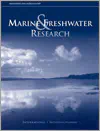Differences in the macrozoobenthic fauna colonising empty bivalve shells before and after invasion by Corbicula fluminea

Abstract
Bivalve shells can potentially alter the structure of aquatic benthic communities. However, little is known about the effect that different shell morphologies have on their associated fauna. This study aimed to understand how empty shells, from four different freshwater bivalve species, affect macrozoobenthic communities, using the River Minho (Iberian Peninsula) as a study area. Three native (Anodonta anatina, Potomida littoralis, Unio delphinus) and one non-indigenous (Corbicula fluminea) species were used for this research. Comparisons among species and between scenarios (i.e. before and after invasion by C. fluminea) were performed. Our results suggest that macrozoobenthic community structure did not vary among treatments, with the exception of species richness, which was higher on shells of native species. Furthermore, little difference was detected when comparing scenarios with and without C. fluminea shells, despite dissimilarities in size and morphology between species. The empty shells of C. fluminea partially (in terms of density and biomass, but not in species richness) replaced the role of empty shells of native species as a physical substratum for the associated macrozoobenthic community.